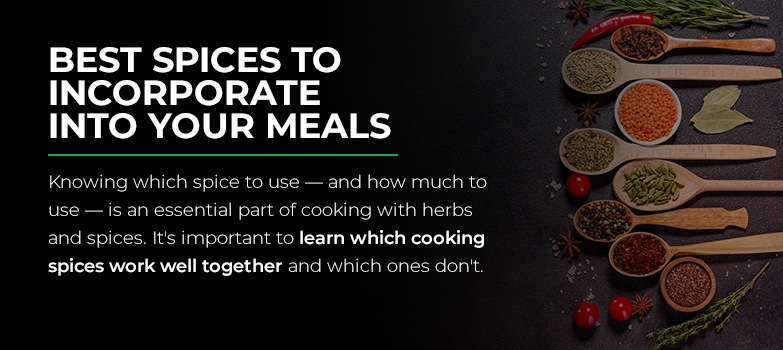How to Use Spices While Cooking
Spices are used to enhance the taste of food, boost its color and add delectable flavor. Cooking with spices requires a delicate balance. Too much of certain spices can overpower a dish, and too little can leave it tasting bland. Figuring out the perfect spice lineup to bring out a dish’s aroma and flavors is possible when you understand how spices work.
10 Tips for Cooking With Spices
Whether you’re just beginning to cook for yourself or are a lifelong cooking enthusiast, there are some things everyone should know when it comes to using spices and herbs:
- Store them properly: Spices should be stored inside air-tight containers in a cool, dark place to remain fresh and flavorful. When air hits the spices, it drains a bit of their flavor and color and speeds up their expiration.
- Experiment with grinding: If you buy spices whole and grind them yourself, try experimenting with how finely you grind them. The fineness of a grind can make the difference between a mild taste, harsh taste and everything in between.
- Buy in bulk: When it comes to spices and herbs, bulk buying can be helpful — especially if you’re buying spices for a recipe you’re trying for the first time or one that you only make on occasion. Buying in bulk allows you to get as much or as little as you need.
- Explore the differences between peppers and chiles: Not all pepper and chile types are spicy and flavorful. It’s a good idea to learn which ground peppers pack flavor and a little heat and which ones are all heat and a little flavor.
- Learn how to “bloom” spices: One way to help bring out a spice’s flavor and aroma is by cooking it in hot oil, a process called “blooming.” You can also use the oil, which has been infused with the flavors of the spices, to flavor your entire dish.
- Learn to toast spices: Toasting is a similar process to blooming. Simply toast spices in a pan before using them to boost their flavor and aroma. Toasting is best with whole spices since ground spices are likely to burn faster.
- Spice meats before cooking: Meat is most absorbent before it’s cooked, so that is the best time to add spices to it. This applies to vegetables as well. In contrast to spices, herbs should always be added during cooking to reap the most benefits.
- Taste as you go: A quick and often overlooked tip for using spices is to taste your food as you’re making it. This can help you avoid going overboard with spices and having them overwhelm your dish — or using too little spice and ending up with a bland dish.
- Experiment with substitutions: Once you have a grasp of the different spices and what they bring to the table, try experimenting with substitutions. This is a great solution for when you find yourself without a particular spice and need to find a workable replacement.
- Build your collection: As you become familiar with using spices, consider building a collection of different types of spices. You can also experiment with mixing them yourself instead of buying pre-mixed spice blends.
Best Spices to Incorporate Into Your Meals

Knowing which spice to use — and how much to use — is an essential part of cooking with herbs and spices. It’s important to learn which cooking spices work well together and which ones don’t. Here are some of the most popular spices used in cooking and some of foods they pair with:
- Cayenne pepper: This spicy pepper has over 200 varieties and is used to give a dish some heat. Given the number of variations available, cayenne peppers are used in cuisines all over the world — from Latin American and Cajun, to African and South Asian.
- Paprika: Made from sweet orange and red peppers that have been dried and ground, paprika has a sweet yet hot flavor. This spice is ideal for staples like eggs, rice, root vegetables and chicken.
- Cumin: Popular in various curries and barbecue mixes, cumin adds a warm and nutty flavor and is great for soups and dry rubs.
- Ginger: You may have seen ginger in various desserts, but it’s also a useful spice for more savory dishes, including beef, tofu and East Asian cuisine.
- Nutmeg: This sweet spice is often used for desserts, but it’s a staple in many South Asian dishes. It’s great for rice, stuffings and sauces.
- Cloves: Dress up your sausages, baked goods or curries with this sweet spice that can be used whole or ground. Be careful, because a little goes a long way with cloves.
- Turmeric: This spice has been a staple in Caribbean and South Asian cuisines for generations, and the rest of the world is starting to catch up. Its earthy flavor is great for curries and pickled foods, and its bright yellow hue can add a little bit of color into a dish.
- Rosemary: Though technically an herb, rosemary has an earthy flavor that is ideal for marinades and most meats. Pair it with garlic powder or thyme for an extra boost of flavor.
- Cardamom: Cardamom’s sweet and spicy flavor is often used in desserts or other sweet dishes and is common in South Asian and Scandanavian cuisines. It’s also great to add flavor to rice or lentils. Like cloves, a little is a lot when it comes to cardamom.
- Basil: Basil is a slightly sweet, leafy herb that goes well with most vegetables, especially potatoes, eggplant and zucchini. It’s also great for salad dressings and dry rubs.
- Coriander: The seeds of the cilantro plant make up coriander, which is used for soups and mulled wines. With a peppery taste that works well on most meats and fish, coriander is a popular spice in South Asian, Caribbean and Mexican dishes.
- Allspice: Though it’s a singular spice, allspice gets its name from its sweet and earthy flavor that tastes like a mixture of cinnamon, nutmeg and cloves. Most common in South American and Jamaican cooking, allspice is the core of jerk seasoning.
Get Cooking With Premio Today
Start playing with flavors by testing some new recipes for your next meal. When you’re shopping for ingredients, use our store locator to find delicious Premio sausages near you, and you’ll be ready to whip up your masterpiece!

